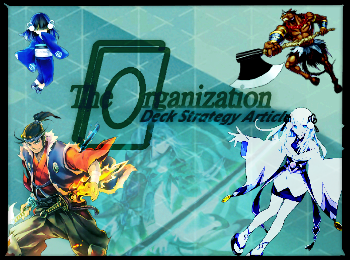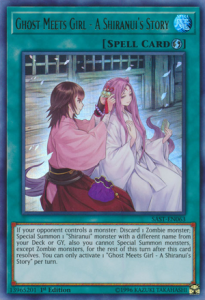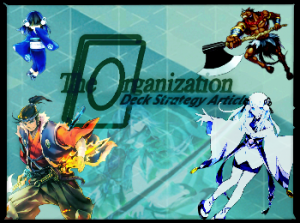What happened when the Ghost met the Girl? A Raid battle like no other…
Welcome to the Synchro Dimension:
The Zombie-type has been emblematic of the Synchro Summoning mechanic from the beginning. By having one of the most prolific tuners within its ranks, the Zombie type has evolved in the modern game to have two main options for playing the deck. The first option is a Zombie World control variant, powering through the opponent’s options through powerful cards such as Doomking Balerdroch. The second option would be to focus around the plethora of Zombie-type Synchro monsters available for use. However, most of these Synchro monsters fall within one of two archetypes – the Shiranui and the Mayakashi. Most duelists stick with one of these archetypes, but why not dare to be creative and try to follow the lore of the Girl meeting the Ghost…
Before we can get too far down the archetypal rabbit holes, we need to talk Zombies as a type, as this type is pretty unique. Zombies have some of the best generic type support out of all types in the game. Between Uni-Zombie modifying its level by getting Zombie monsters to your GY, Mezuki banishing itself from your GY to Special Summon back any other Zombie from your GY, or even multiple monsters that make any Zombie-type searchable such as Goblin Zombie or Glow-Up Bloom. All of these cards require careful card design to avoid making any archetype too powerful with the combination of archetype support and the generic support available, so there are some limitations to play around, but the possibilities are endless when you are creating a deck with monsters of this type.
I’ll come back to this mix of generic and archetypal support later, so let’s dive into the starring archetypes for today’s strategy!
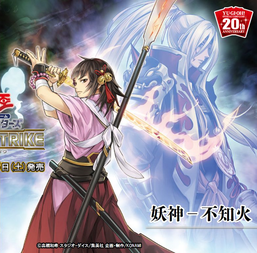
The Shiranui:
First up for our discussion is the group of FIRE/Zombie monsters themed around the forging and wielding of ancestral blades. Each Shiranui features two effects, but they are all tied together by having a second effect that triggers when the monster is banished. This was the first Zombie theme that wanted to banish themselves rather than just the type support cards, so it was a neat twist when the theme first emerged as a legacy Synchro archetype. Their Synchro monsters range in levels from 5 to 10, and they even received their own Link monster as part of their legacy support in the Vrains era. This theme was particularly designed to thrive in the presence of the generic Zombie support cards, as you should notice from their key cards!
 Talking about there key cards, there is no bigger player than Shiranui Solitaire. This Level 4 monster is both a starter and extender for the theme, his first affect allows you to tribute any Zombie to Special Summon a Zombie-type tuner with 0 DEF from your deck and his second effect lets you Special Summon a banished Shiranui when it is banished. The primary summon off of Solitaire’s first effect should typically be Uni-Zombie; however, you can also summon either of the Shiranui Tuners also – Shiranui Spectralsword and Shiranui Spectralsword Shade. The first, a Level 2 for the long game, has an effect that can be activate in the GY to pseudo-Synchro Summon by banishing itself and another Zombie-type monster from your GY. The second, a Level 3 extender, can be tributed to Special Summon 2 of your banished Zombies, as long as one of them is a Shiranui. Shade wrings even more potential out of your essential Zombies, especially when banishing a lot of Zombies!
Talking about there key cards, there is no bigger player than Shiranui Solitaire. This Level 4 monster is both a starter and extender for the theme, his first affect allows you to tribute any Zombie to Special Summon a Zombie-type tuner with 0 DEF from your deck and his second effect lets you Special Summon a banished Shiranui when it is banished. The primary summon off of Solitaire’s first effect should typically be Uni-Zombie; however, you can also summon either of the Shiranui Tuners also – Shiranui Spectralsword and Shiranui Spectralsword Shade. The first, a Level 2 for the long game, has an effect that can be activate in the GY to pseudo-Synchro Summon by banishing itself and another Zombie-type monster from your GY. The second, a Level 3 extender, can be tributed to Special Summon 2 of your banished Zombies, as long as one of them is a Shiranui. Shade wrings even more potential out of your essential Zombies, especially when banishing a lot of Zombies!
 Supporting this Shiranui core is additional recovery, starters, and disruption. Shiranui Squire can first Special Summon one of your Spectralswords from the deck when it is Normal Summoned, and when it is banished, you can draw 1 card then discard 1 card. Shiranui Samurai can banish a Zombie from your GY to turn into a D.D. Warrior Lady for the rest of the turn, and when it is banished, you get to add a Shiranui back from your GY to the hand. Lastly, Shiranui Spiritmaster can Special Summon another Shiranui from your hand or GY when it is Normal Summoned, and when it is banished, you can target and destroy 1 face-up card your opponent controls. While there are a couple other Shiranui monsters exist, they don’t provide any additional power to our hybrid build, so I’m going to leave them alone for now.
Supporting this Shiranui core is additional recovery, starters, and disruption. Shiranui Squire can first Special Summon one of your Spectralswords from the deck when it is Normal Summoned, and when it is banished, you can draw 1 card then discard 1 card. Shiranui Samurai can banish a Zombie from your GY to turn into a D.D. Warrior Lady for the rest of the turn, and when it is banished, you get to add a Shiranui back from your GY to the hand. Lastly, Shiranui Spiritmaster can Special Summon another Shiranui from your hand or GY when it is Normal Summoned, and when it is banished, you can target and destroy 1 face-up card your opponent controls. While there are a couple other Shiranui monsters exist, they don’t provide any additional power to our hybrid build, so I’m going to leave them alone for now.
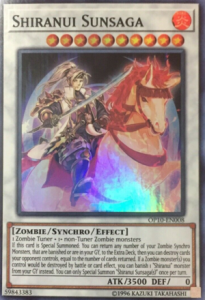 The last set of Shiranui I need to discuss to properly introduce the theme are the most important Extra Deck members. Shiranui Squiresaga can banish 1 monster from your field or GY, then gain ATK if the banished monster was Zombie, destroy a Spell/Trap if it was FIRE, then destroy a monster if it was a Synchro. As all the other Shiranui meet all 3 conditions, this can be a key option for disrupting your opponent’s board. Next up is Shiranui Sunsaga, which can return any of your Zombie Synchros that are banished or in your GY to destroy an equal number of cards on the field. Also it carries a continuous effect to banish a Shiranui from your GY to prevent the destruction of a Zombie monster. The last key monster is Shiranui Skillsaga Supremacy, a Link 3 monster that can Special Summon a banished Zombie Synchro monster during your opponent’s turn, as well as protecting FIRE monsters from battle and Synchro monsters from destruction by effect. All things consider, these effects and the other Shiranui Synchros can empower your deck to outlast and outresource most threats an opponent can throw at you.
The last set of Shiranui I need to discuss to properly introduce the theme are the most important Extra Deck members. Shiranui Squiresaga can banish 1 monster from your field or GY, then gain ATK if the banished monster was Zombie, destroy a Spell/Trap if it was FIRE, then destroy a monster if it was a Synchro. As all the other Shiranui meet all 3 conditions, this can be a key option for disrupting your opponent’s board. Next up is Shiranui Sunsaga, which can return any of your Zombie Synchros that are banished or in your GY to destroy an equal number of cards on the field. Also it carries a continuous effect to banish a Shiranui from your GY to prevent the destruction of a Zombie monster. The last key monster is Shiranui Skillsaga Supremacy, a Link 3 monster that can Special Summon a banished Zombie Synchro monster during your opponent’s turn, as well as protecting FIRE monsters from battle and Synchro monsters from destruction by effect. All things consider, these effects and the other Shiranui Synchros can empower your deck to outlast and outresource most threats an opponent can throw at you.
But as I said at the beginning, the Shiranui is just the start, for we have other Zombie archetypes to discuss. Rise from the grave and let’s continue!
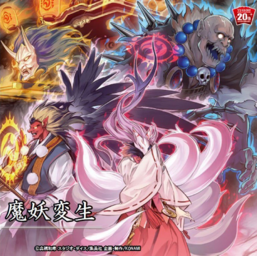
The Mayakashi:
The second archetype up for discussion is a group of laddering Yōkai from Japanese folklore and Chinese mythology. Each Mayakashi is designed to facilitate the initiation or continuation of a Synchro ladder, first summoning a level 3 Synchro monster, using that to Synchro a level 5, then up the chain of odd levels until you make their boss monster a Level 11 Synchro. Then, once you have Mayakashi synchros in your GY, they can bring themselves back and apply beneficial effects whenever a Synchro monster is destroyed and sent to the GY that was 2 levels higher. In short, the theme ladders up then revives back down the ladder. Additionally, the only cost for this revival is banishing a Zombie monster from your GY! Perfect!
 This whole playstyle is enabled by Dakki, the Graceful Mayakashi. This Level 2 tuner can be Special Summoned from the GY whenever you summon a Mayakashi monster from the Extra Deck… as many times as you want. Thus, this is the tuner that makes the ladder climb possible. To initiate the climb, Hajun, the Winged Mayakashi can Special Summon any other Mayakashi from your deck when summoned (READ – Dakki), giving you a 1-card starter. There is also Yuki-Musume, the Ice Mayakashi, another Level 1 that can Special Summon itself from your hand or GY while you control a Mayakashi, then you have to send 1 Zombie monster from your Deck to the GY. This then fuels further combos, as you can send something like Mezuki to force your Zombies to arise back from the GY.
This whole playstyle is enabled by Dakki, the Graceful Mayakashi. This Level 2 tuner can be Special Summoned from the GY whenever you summon a Mayakashi monster from the Extra Deck… as many times as you want. Thus, this is the tuner that makes the ladder climb possible. To initiate the climb, Hajun, the Winged Mayakashi can Special Summon any other Mayakashi from your deck when summoned (READ – Dakki), giving you a 1-card starter. There is also Yuki-Musume, the Ice Mayakashi, another Level 1 that can Special Summon itself from your hand or GY while you control a Mayakashi, then you have to send 1 Zombie monster from your Deck to the GY. This then fuels further combos, as you can send something like Mezuki to force your Zombies to arise back from the GY.
Turning to the Mayakashi Extra Deck suite, here’s a quick summary:
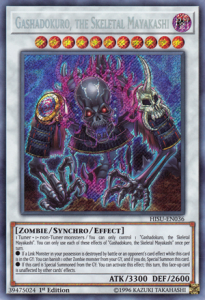 Monster Name – Level – Effect when Summoned from GY
Monster Name – Level – Effect when Summoned from GY- Gashadokuro, the Skeletal Mayakashi – Level 11 – Unaffected by card effects
- Yoko, the Graceful Mayakashi – Level 9 – 1 Monster destruction
- Tengu, the Winged Mayakashi – Level 7 – 1 Spell/Trap destruction
- Tsuchigumo, the Poisonous Mayakashi – Level 5 – 3 cards milled from both players’ decks
- Oboro-Guruma, the Wheeled Mayakashi – Level 3 – All your monsters protected from destruction by battle for the turn
- Yuki-Onna, the Ice Mayakashi – LINK 2 – Can’t be attacked while it points to a Synchro, and when a Synchro is destroyed, you get to halve the ATK/DEF of an opponent’s monster
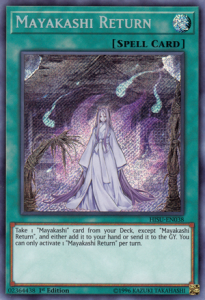 Rounding out the essential support for this theme are two key support spells. First, the Mayakashi have a tutor spell in the form of Mayakashi Return which lets you take a Mayakashi card from your deck then add it to your hand or send it to the GY. This significantly boosts the odds of opening that Synchro ladder you desperately crave as well as well as unlocking other options if you already have your Hajun. The second card is a Continuous Spell, Mayakashi Winter, that continuously reduces the ATK/DEF of your opponent’s monsters by 100 for each Mayakashi in your GY with a different name. Its second effect sends itself and a Mayakashi you control to the GY to draw a card, then its third effect lets you banish itself and another Zombie to Special Summon any Mayakashi monster from your GY. These effects work in tandem to ensure your Yōkai can trigger their Special Summoning effects, even if your opponent got around the first wave without destroying anything!
Rounding out the essential support for this theme are two key support spells. First, the Mayakashi have a tutor spell in the form of Mayakashi Return which lets you take a Mayakashi card from your deck then add it to your hand or send it to the GY. This significantly boosts the odds of opening that Synchro ladder you desperately crave as well as well as unlocking other options if you already have your Hajun. The second card is a Continuous Spell, Mayakashi Winter, that continuously reduces the ATK/DEF of your opponent’s monsters by 100 for each Mayakashi in your GY with a different name. Its second effect sends itself and a Mayakashi you control to the GY to draw a card, then its third effect lets you banish itself and another Zombie to Special Summon any Mayakashi monster from your GY. These effects work in tandem to ensure your Yōkai can trigger their Special Summoning effects, even if your opponent got around the first wave without destroying anything!
With that, we’ve officially covered the two main Zombie synchro archetypes for this article – but I would be remiss if I didn’t cover a third archetype that recently came to the TCG and boosted this hybrid into an actual threat. That’s right, it’s time to bring on the Raid Battle.
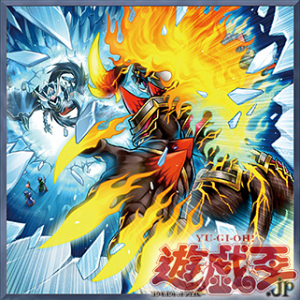
The Generaider Engine:
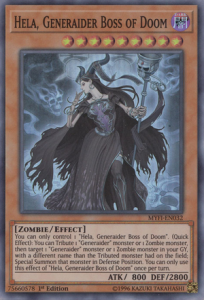 The Generaider theme, recently released in Mystic Fighters, consists of an archetype of multi-type/attribute Level 9 monsters, each boasting a unique quick effect that supports not only the archetype but also its own type! One such type supported by this archetype just happens to be Zombies, with its representative being Hela, Generaider Boss of Doom. Hela can tribute any Generaider or Zombie monster you control to Special Summon a Generaider or Zombie from your GY with a different name. As this is a quick effect, this is exactly what Mayakashi ordered, as now you have a way to trigger their Summon from GY effects during the opponent’s turn! The other major benefit to Hela is that she is just a big body – with 2800 DEF, your opponent is going to have to commit to the field to get rid of Hela, let alone get rid of the other monster she summons.
The Generaider theme, recently released in Mystic Fighters, consists of an archetype of multi-type/attribute Level 9 monsters, each boasting a unique quick effect that supports not only the archetype but also its own type! One such type supported by this archetype just happens to be Zombies, with its representative being Hela, Generaider Boss of Doom. Hela can tribute any Generaider or Zombie monster you control to Special Summon a Generaider or Zombie from your GY with a different name. As this is a quick effect, this is exactly what Mayakashi ordered, as now you have a way to trigger their Summon from GY effects during the opponent’s turn! The other major benefit to Hela is that she is just a big body – with 2800 DEF, your opponent is going to have to commit to the field to get rid of Hela, let alone get rid of the other monster she summons.
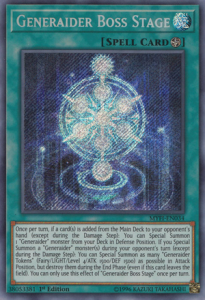 As for why we can consider running a random Level 9 monster in the middle of a combo-intensive hybrid strategy, well that comes down to the core card of the Generaider archetype – their field spell. Generaider Boss Stage is one of the best Field Spells to be ever printed. First, whenever your opponent adds a card from the deck to their hand, you can Special Summon 1 Generaider from your Deck. Note – this includes when they draw a card for the start of their turn. The secondly, whenever a Generaider is summoned during the opponent’s turn, you can special summon as many Generaider tokens as possible. So not only does the field spell get you a copy of Hela, but it also gives you tribute fodder for her effect as well! Again, the key synergy here is that you can trigger your Mayakashi effects during the opponent’s turn, but there is one more important obstacle that Hela also overcomes – restrictions.
As for why we can consider running a random Level 9 monster in the middle of a combo-intensive hybrid strategy, well that comes down to the core card of the Generaider archetype – their field spell. Generaider Boss Stage is one of the best Field Spells to be ever printed. First, whenever your opponent adds a card from the deck to their hand, you can Special Summon 1 Generaider from your Deck. Note – this includes when they draw a card for the start of their turn. The secondly, whenever a Generaider is summoned during the opponent’s turn, you can special summon as many Generaider tokens as possible. So not only does the field spell get you a copy of Hela, but it also gives you tribute fodder for her effect as well! Again, the key synergy here is that you can trigger your Mayakashi effects during the opponent’s turn, but there is one more important obstacle that Hela also overcomes – restrictions.
The Mayakashi theme has one major drawback – they are very archetype locked, especially at first glance. By using Dakki’s effect just once, you lock yourself into summoning only Mayakashi monsters from the Extra Deck for the rest of the turn. Similarly, all of the non-tuners of the Mayakashi theme have a continuous restriction that “You cannot Special Summon monsters from the Extra Deck, except “Mayakashi” monsters.” While you may be able to get some of those non-tuners off the field by making a Mayakashi Link Summon into Yuki-Onna, you will often be left in a situation where you have one that would potential stop your Shiranui plays. So this is where Hela enters the fray again – by tributing away a Mayakashi with the restriction, you can ensure that you have nothing stopping you from wielding the Shiranui side of your plays. It’s also helpful to note that Solitaire shares a similar role in the ‘tributing of Mayakashi’ department.
All that aside, I think we’ve covered the strengths of these three themes. So let’s see how they look when you throw them all together.
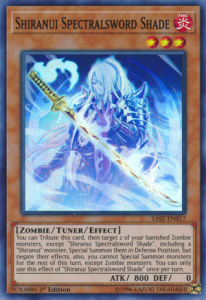
Sample Decklist:
Click Here to view an interactive decklist in the Official Card Database.
Spoiler
Monsters: 25
|| Dakki, the Graceful Mayakashi
||| Hajun, the Winged Mayakashi
| Shafu, the Wheeled Mayakashi
| Yuki-Musume, the Ice Mayakashi
||| Shiranui Solitaire
| Shiranui Samurai
| Shiranui Spiritmaster
| Shiranui Squire
| Shiranui Spectralsword
| Shiranui Spectralsword Shade
|| Hela, Generaider Boss of Doom
||| Mezuki
| Uni-Zombie
|| Ash Blossom & Joyous Spring
|| Orbital Hydralander
Spells: 15
||| Mayakashi Return
|| Mayakashi Winter
|| Ghost Meets Girl: A Shiranui Story
||| Generaider Boss Stage
| Terraforming
| Foolish Burial
| One for One
| Monster Reborn
| Gold Sarcophagus
Extra Deck:
| Gashadokuro, the Skeletal Mayakashi
| Yoko, the Graceful Mayakashi
| Tengu, the Winged Mayakashi
| Tschigumo, the Poisonous Mayakashi
| Oboro-Guruma, the Wheeled Mayakashi
| Shiranui Sunsaga
| Shiranui Shogunsaga
| Shiranui Squiresaga
| Shiranui Swordsaga
| PSY-Framelord Omega
|| Yuki-Onna, the Ice Mayakashi
| Vampire Sucker
| Avendread Savior
| Shiranui Skillsaga Supremecy
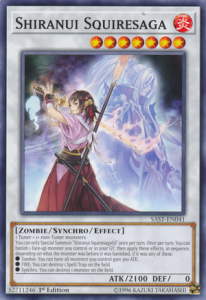
Turn-Based Strategy:
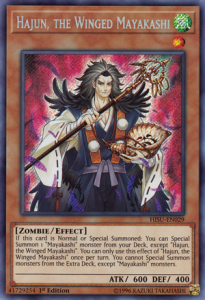 This deck is very interesting in that each turn you have different goals and different archetypes to exploit in executing those goals. Turn one, you want to set up your Mayakashi above anything else. So this means get to your Hajun->Dakki->ladder, then hopefully end on a Boss Stage. During Turn two, you want to use the effect of Hela to disrupt your opponent’s plays by bringing back your Mayakashi, as well as ride out any OTK push with the help of your cascading Mayakashi ladder. Then Turn three, it’s time to turn to the Shiranui to setup your grind game by looping through all available options to take you home to victory. Along the way, you even have ways to innovate, as your combos are extremely non-linear once your Mayakashi ladder is enacted. The only limiting factor to the deck is your ability to maintain proper control and choice over your GY and banished resources, as well as remaining aware of how many copies of Winter and Mezuki you have at your disposal to get back in the duel in the off-chance that your opponent overwhelms your setup field.
This deck is very interesting in that each turn you have different goals and different archetypes to exploit in executing those goals. Turn one, you want to set up your Mayakashi above anything else. So this means get to your Hajun->Dakki->ladder, then hopefully end on a Boss Stage. During Turn two, you want to use the effect of Hela to disrupt your opponent’s plays by bringing back your Mayakashi, as well as ride out any OTK push with the help of your cascading Mayakashi ladder. Then Turn three, it’s time to turn to the Shiranui to setup your grind game by looping through all available options to take you home to victory. Along the way, you even have ways to innovate, as your combos are extremely non-linear once your Mayakashi ladder is enacted. The only limiting factor to the deck is your ability to maintain proper control and choice over your GY and banished resources, as well as remaining aware of how many copies of Winter and Mezuki you have at your disposal to get back in the duel in the off-chance that your opponent overwhelms your setup field.
 Another thing of note – outside of just shutting down all hand traps with Azzathot, this strategy can be one of the most resilient to hand traps. This is because you have so much of an opportunity to outplay your opponent with mind games. Even if you already have Hajun in hand, use your Mayakashi Return first to try and dupe them into using their Ash Blossom. Additionally it’s important to note that there are more combinations that get you to your initial Synchro ladder beyond just relying upon Hajun. Dakki or Solitaire + Yuki-Musume also gives you that opening ladder. In fact, the probability of opening that Mayakashi synchro ladder is only slightly shy of 75% when you count all the combinations. In the other 25% of your games, you can turn to Shiranui to kick off your combos. While they might not be as powerful as a Mayakashi setup, they have options as well to get you on your way to controlling a duel from its onset!
Another thing of note – outside of just shutting down all hand traps with Azzathot, this strategy can be one of the most resilient to hand traps. This is because you have so much of an opportunity to outplay your opponent with mind games. Even if you already have Hajun in hand, use your Mayakashi Return first to try and dupe them into using their Ash Blossom. Additionally it’s important to note that there are more combinations that get you to your initial Synchro ladder beyond just relying upon Hajun. Dakki or Solitaire + Yuki-Musume also gives you that opening ladder. In fact, the probability of opening that Mayakashi synchro ladder is only slightly shy of 75% when you count all the combinations. In the other 25% of your games, you can turn to Shiranui to kick off your combos. While they might not be as powerful as a Mayakashi setup, they have options as well to get you on your way to controlling a duel from its onset!
One last note on my seemingly weird tech of Orbital Hydralander – the opening Mayakashi combo basically guarantees that you get 5 monsters to the GY with different names. Between all of the other GY manipulation available to you, you should be able to help his effect and/or summoning condition be live whenever you wish. Thus – it’s a great additional card to throw with your opening board!
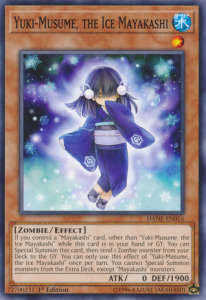
Additional Tech Options:
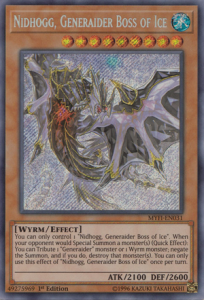 Expanded Archetype Suites
Expanded Archetype Suites
- Nidhogg, Generaider Boss of Ice – Another great Generaider to bring out with a Boss Stage, this just lets you negate a Special Summon by tributing a token instead of reviving a Zombie with Hela. In short, more versatility and disruption at your fingertips.
- Shiranui Style Samsara – As Solitaire’s banish effect is doubled if you have a Shiranui Style Synthesis on the field, this trap can be a decent stand-in since it protects you from all damage or lets you recycle your banished Zombies. Both effects are key in a strategy that looks to extend the duel as long as possible to outlast the opponent.
- Shiranui Style Swallow’s Slash – Themed Icarus Attack for Zombies, just you also get to banish a Shiranui. This can trigger Spiritmaster for a third destruction, or Solitiare for a summon, just as examples. In short, multi-card disruption.
- Mayakashi Metamorphosis – An additional Mayakashi card that lets you summon back a Mayakashi on demand to trigger their effects – the main reason it didn’t make the cut for my build is due to requiring a discard.
- Vendread Reorigin – Non-destruction removal, the downside is that you need to control another Zombie so you can link away the token and your other Zombie for Avendread Savior before you can continue playing the duel!
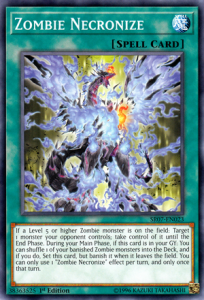 Generic Zombie Support
Generic Zombie Support
- Return of the Zombies – Great Trap that lets you both trigger a Shiranui and get back a Zombie from the GY. Plus it can recycle itself while recycling banished Zombie resources!
- Zombie Necronize – Similar to the above in its recycling capabilities, but since you should always have a Synchro on the field, the condition is easy to give yourself ways to steal your opponent’s monsters!
- Vampire Fraulein – Hand trap for Zombies to ensure that you win battles! It’s a great card to consider teching in a copy!
- Gozuki – Looking for more starters? Look no further than this guy who pairs well with all your other Zombies.
- Soul-Absorbing Bone Tower – The Mayakashi FTK is a thing with this card due to how many Special Summons are possible with the theme. So you can consider running a copy or a couple for the offchance you can pull off that FTK.
- Haunted Shrine – Generic version of the Mayakashi trap, but it has a restriction that you control no monsters. In exchange, you can use its effect twice, once on the field and once from the GY. This also would give you a better justification to use Foolish Burial Goods as well in the build.
 Weird Options:
Weird Options:
- Jewels of the Valiant – With Zombies of different attributes, this card can be used alongside Mezuki to send a Yuki-Musume which then can send another Mezuki. Or with any of your Shiranuis too!
- Future Fusion – With its recent errata and the existance of a Fusion requiring any 2 Zombies, this card can be used as a delayed double Foolish Burial, something Zombies love. This can be a great bait to pull the backrow destruction your opponent would have pointed at Boss Stage!
- Dragon’s Mirror – Same as the above in combing with Dragonecro Nethersoul Dragon. Banish 2 Shiranui from your GY, Summon Nether, then trigger your Shiranui effects for profit.

Looking Forward:
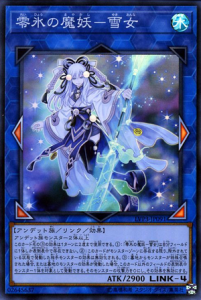 Multiple cards are on the horizon that could greatly impact this deck, so I’m going to take the time to discuss them briefly. First is the second Mayakashi link monster, Yuki-Onna, the Absolute Zero Mayakashi (YGOrg Translation). This Link 4 monster gives you a floodgate stopping your opponent’s banished monsters from activating (take that Thunder Dragon), but it also can negate the effects of a monster and turn its ATK to 0 whenever another monster is summoned from the GY or when a monster effect is activated in the GY. All things considered, this is an amazing addition to the family, one that would actually give a Mayakashi variant a leg-up on certain meta contenders currently dominating most lower-tier decks from reaching competitive levels.
Multiple cards are on the horizon that could greatly impact this deck, so I’m going to take the time to discuss them briefly. First is the second Mayakashi link monster, Yuki-Onna, the Absolute Zero Mayakashi (YGOrg Translation). This Link 4 monster gives you a floodgate stopping your opponent’s banished monsters from activating (take that Thunder Dragon), but it also can negate the effects of a monster and turn its ATK to 0 whenever another monster is summoned from the GY or when a monster effect is activated in the GY. All things considered, this is an amazing addition to the family, one that would actually give a Mayakashi variant a leg-up on certain meta contenders currently dominating most lower-tier decks from reaching competitive levels.
 The second card is the partner spell for the Mayakashi archetype: Ghost Meets Girl: a Mayakashi Story (YGOrg Translation). This spell is clearly connected via lore to Ghost Meets Girl: a Shiranui Story, but it is much more generic in terms of effects. By targeting a Zombie Synchro you control, you get to Special Summon a Zombie with the same attribute from your GY or that is banished. This gives your deck yet another amazing recovery option, whether it is bringing back Mezuki by targeting a Oboro-Guruma or bringing back any of your Shiranuis by targeting a Yoko or any of your Shiranui synchros. It definitely adds an extra dimension to the strategy, giving you yet another way to influence the duel during your opponent’s turn!
The second card is the partner spell for the Mayakashi archetype: Ghost Meets Girl: a Mayakashi Story (YGOrg Translation). This spell is clearly connected via lore to Ghost Meets Girl: a Shiranui Story, but it is much more generic in terms of effects. By targeting a Zombie Synchro you control, you get to Special Summon a Zombie with the same attribute from your GY or that is banished. This gives your deck yet another amazing recovery option, whether it is bringing back Mezuki by targeting a Oboro-Guruma or bringing back any of your Shiranuis by targeting a Yoko or any of your Shiranui synchros. It definitely adds an extra dimension to the strategy, giving you yet another way to influence the duel during your opponent’s turn!
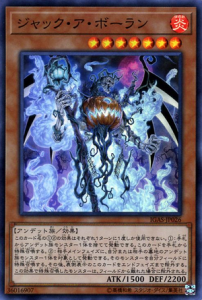 The third card is also slated for release in the next core set – Jack A’ Boolan (YGOrg Translation). While this monster is definitely going to find a first home in Zombie World variants, its quick effect to summon a Zombie from your GY is a perfect match with all of your Mayakashi Synchros. I mean, just think of the bare minimum if Jack serves as a stand-in for a Hela if you fail to draw into one of your copies of Boss Stage. Jack also opens the door to easily triggering your Shiranui monsters since it banishes the monster it summons, so that’s just an additional plus for this mishmash of strategies. Out of all these cards, this is definitely the most versatile as it supports every single Zombie archetype in the game, and not just at a bare minimum, it can have a massive impact!
The third card is also slated for release in the next core set – Jack A’ Boolan (YGOrg Translation). While this monster is definitely going to find a first home in Zombie World variants, its quick effect to summon a Zombie from your GY is a perfect match with all of your Mayakashi Synchros. I mean, just think of the bare minimum if Jack serves as a stand-in for a Hela if you fail to draw into one of your copies of Boss Stage. Jack also opens the door to easily triggering your Shiranui monsters since it banishes the monster it summons, so that’s just an additional plus for this mishmash of strategies. Out of all these cards, this is definitely the most versatile as it supports every single Zombie archetype in the game, and not just at a bare minimum, it can have a massive impact!
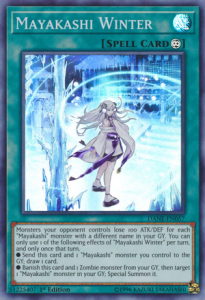
Conclusion:
At the end of the day, we’ve talked a lot about the walking dead and how various Zombie archetypes can band together in their quest to eat brains. But hopefully this inspired you to think a bit more creatively about other monster types as well – while archetypes are the primary vessel for winning strategies, you can truly develop a unique powerhouse by combining various strategies then knitting them together with common support cards! After all, that’s primarily how the Striker Orcust build came into existence, so why not augment the capabilities of other archetypes to get them into a more powerful state. Either way, I wish you the best on your journey and hope that you enjoyed reading!
Reminder, I also take suggestions for future CDS articles! I really want to see some input from you! If you wish to see a CDS article about the archetype, theme, or strategy you love, feel free to private message me on the YGOrg Discord server, the YGOrganization Forums, or just post a comment in response to this article on our Facebook page with your ideas to keep under consideration! On most YGO-related communities my username is Quincymccoy, so feel free to reach out.

